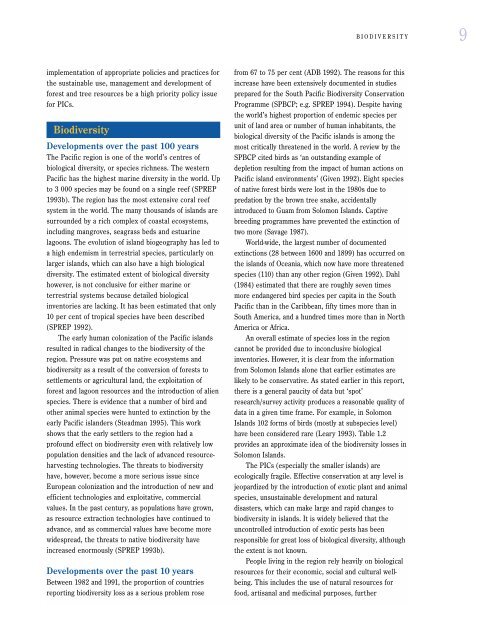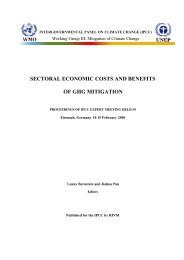Pacific Islands Environment Outlook - UNEP
Pacific Islands Environment Outlook - UNEP
Pacific Islands Environment Outlook - UNEP
You also want an ePaper? Increase the reach of your titles
YUMPU automatically turns print PDFs into web optimized ePapers that Google loves.
BIODIVERSITY 9<br />
implementation of appropriate policies and practices for<br />
the sustainable use, management and development of<br />
forest and tree resources be a high priority policy issue<br />
for PICs.<br />
Biodiversity<br />
Developments over the past 100 years<br />
The <strong>Pacific</strong> region is one of the world’s centres of<br />
biological diversity, or species richness. The western<br />
<strong>Pacific</strong> has the highest marine diversity in the world. Up<br />
to 3 000 species may be found on a single reef (SPREP<br />
1993b). The region has the most extensive coral reef<br />
system in the world. The many thousands of islands are<br />
surrounded by a rich complex of coastal ecosystems,<br />
including mangroves, seagrass beds and estuarine<br />
lagoons. The evolution of island biogeography has led to<br />
a high endemism in terrestrial species, particularly on<br />
larger islands, which can also have a high biological<br />
diversity. The estimated extent of biological diversity<br />
however, is not conclusive for either marine or<br />
terrestrial systems because detailed biological<br />
inventories are lacking. It has been estimated that only<br />
10 per cent of tropical species have been described<br />
(SPREP 1992).<br />
The early human colonization of the <strong>Pacific</strong> islands<br />
resulted in radical changes to the biodiversity of the<br />
region. Pressure was put on native ecosystems and<br />
biodiversity as a result of the conversion of forests to<br />
settlements or agricultural land, the exploitation of<br />
forest and lagoon resources and the introduction of alien<br />
species. There is evidence that a number of bird and<br />
other animal species were hunted to extinction by the<br />
early <strong>Pacific</strong> islanders (Steadman 1995). This work<br />
shows that the early settlers to the region had a<br />
profound effect on biodiversity even with relatively low<br />
population densities and the lack of advanced resourceharvesting<br />
technologies. The threats to biodiversity<br />
have, however, become a more serious issue since<br />
European colonization and the introduction of new and<br />
efficient technologies and exploitative, commercial<br />
values. In the past century, as populations have grown,<br />
as resource extraction technologies have continued to<br />
advance, and as commercial values have become more<br />
widespread, the threats to native biodiversity have<br />
increased enormously (SPREP 1993b).<br />
Developments over the past 10 years<br />
Between 1982 and 1991, the proportion of countries<br />
reporting biodiversity loss as a serious problem rose<br />
from 67 to 75 per cent (ADB 1992). The reasons for this<br />
increase have been extensively documented in studies<br />
prepared for the South <strong>Pacific</strong> Biodiversity Conservation<br />
Programme (SPBCP; e.g. SPREP 1994). Despite having<br />
the world’s highest proportion of endemic species per<br />
unit of land area or number of human inhabitants, the<br />
biological diversity of the <strong>Pacific</strong> islands is among the<br />
most critically threatened in the world. A review by the<br />
SPBCP cited birds as ‘an outstanding example of<br />
depletion resulting from the impact of human actions on<br />
<strong>Pacific</strong> island environments’ (Given 1992). Eight species<br />
of native forest birds were lost in the 1980s due to<br />
predation by the brown tree snake, accidentally<br />
introduced to Guam from Solomon <strong>Islands</strong>. Captive<br />
breeding programmes have prevented the extinction of<br />
two more (Savage 1987).<br />
World-wide, the largest number of documented<br />
extinctions (28 between 1600 and 1899) has occurred on<br />
the islands of Oceania, which now have more threatened<br />
species (110) than any other region (Given 1992). Dahl<br />
(1984) estimated that there are roughly seven times<br />
more endangered bird species per capita in the South<br />
<strong>Pacific</strong> than in the Caribbean, fifty times more than in<br />
South America, and a hundred times more than in North<br />
America or Africa.<br />
An overall estimate of species loss in the region<br />
cannot be provided due to inconclusive biological<br />
inventories. However, it is clear from the information<br />
from Solomon <strong>Islands</strong> alone that earlier estimates are<br />
likely to be conservative. As stated earlier in this report,<br />
there is a general paucity of data but ‘spot’<br />
research/survey activity produces a reasonable quality of<br />
data in a given time frame. For example, in Solomon<br />
<strong>Islands</strong> 102 forms of birds (mostly at subspecies level)<br />
have been considered rare (Leary 1993). Table 1.2<br />
provides an approximate idea of the biodiversity losses in<br />
Solomon <strong>Islands</strong>.<br />
The PICs (especially the smaller islands) are<br />
ecologically fragile. Effective conservation at any level is<br />
jeopardized by the introduction of exotic plant and animal<br />
species, unsustainable development and natural<br />
disasters, which can make large and rapid changes to<br />
biodiversity in islands. It is widely believed that the<br />
uncontrolled introduction of exotic pests has been<br />
responsible for great loss of biological diversity, although<br />
the extent is not known.<br />
People living in the region rely heavily on biological<br />
resources for their economic, social and cultural wellbeing.<br />
This includes the use of natural resources for<br />
food, artisanal and medicinal purposes, further

















